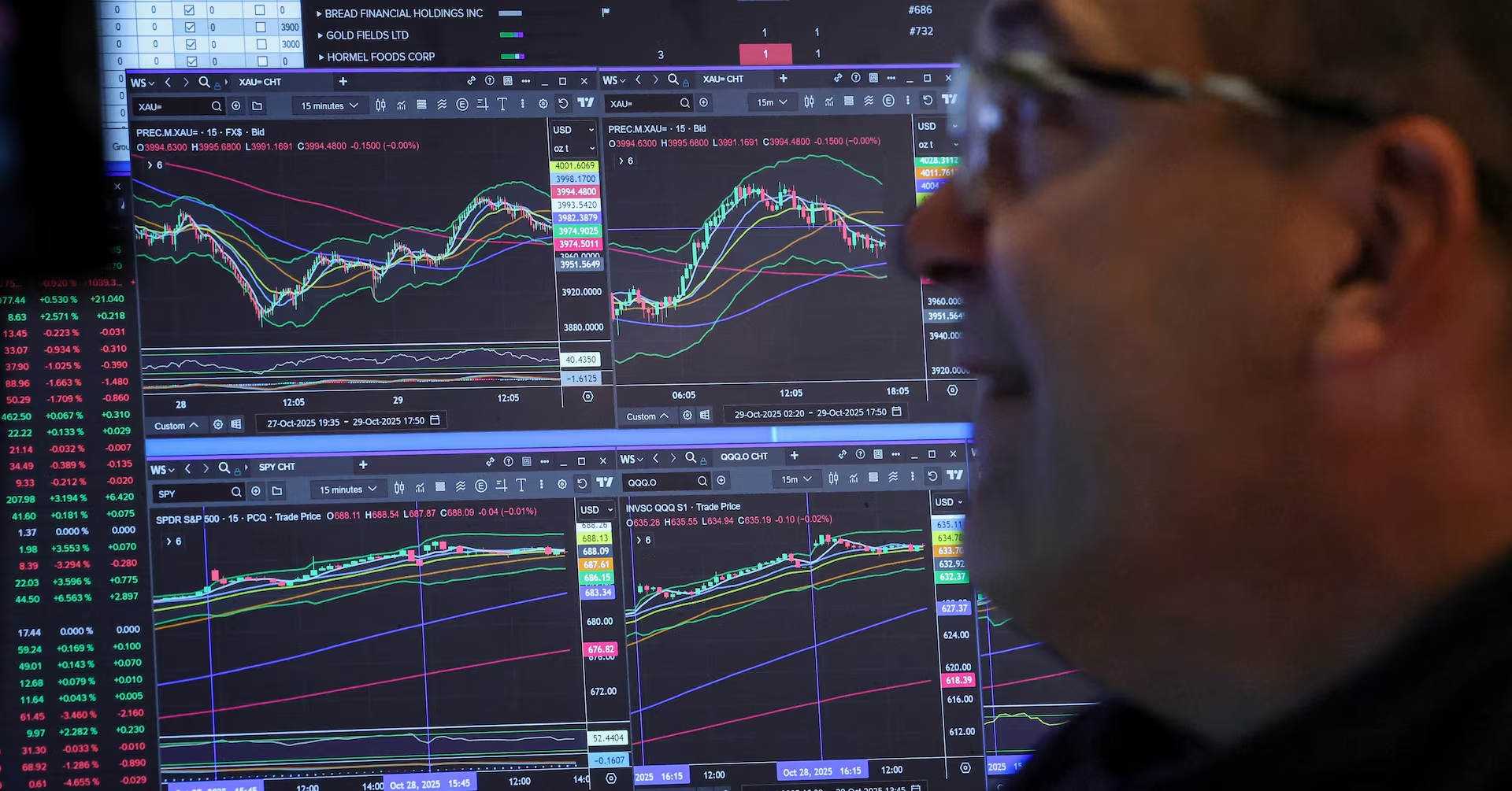S&P 500, Nasdaq slide as Meta, Microsoft fall on AI spending concerns

- Indexes: Dow up 0.24%, S&P 500 down 0.47%, Nasdaq down 0.98%
- Alphabet jumps on quarterly earnings beat
- Meta drops after flagging bigger capex
- Microsoft reveals massive AI spending, shares down
Oct 30 (Reuters) – The S&P 500 and the Nasdaq Composite dropped on Thursday, as Meta and Microsoft fell on worries over surging AI spending, while investors also digested a more hawkish tone from the U.S. Federal Reserve.
Meta (META.O) shares plunged about 11% and were set for the biggest percentage drop in three years after the social media company forecast “notably larger” capital expenses next year, thanks to investments in artificial intelligence.Microsoft (MSFT.O) dipped 3% after the tech giant reported a record capital expenditure of nearly $35 billion for its fiscal first quarter and warned that spending would rise this year.The results followed the Federal Reserve’s delivery on Wednesday of a widely expected quarter-point rate cut but raised doubts about future policy moves when Chair Jerome Powell said that another cut in December was not a “foregone conclusion.”
This had led traders to pare back the odds of another cut in December to about 70%, down from more than 90% earlier in the week.
Thursday’s market is at least in part a “legacy from yesterday,” according to Jack McIntyre, portfolio manager at Brandywine Global, adding that it makes sense for the Fed to say that December easing is not a done deal.
“They don’t want too be beholden to the market,” said McIntyre, adding dollar and Treasury yield gains were factors in equity weakness on Thursday.
And while investors were disappointed with some of the day’s earnings reports, the Fed has to take a relatively strong reporting season into account when deciding if more rate cuts are needed.
“If you’re measuring the economy on Q3 earnings the economy is still doing well,” he said.
Of the 222 S&P 500 companies that have reported so far, 84.2% have beaten earnings estimates as of Wednesday, according to LSEG data. That’s above the 77% average over the past four quarters.
At 2:09 p.m. the Dow Jones Industrial Average (.DJI) rose 113.45 points, or 0.24%, to 47,745.45, the S&P 500 (.SPX) lost 32.21 points, or 0.47%, to 6,858.38 and the Nasdaq Composite (.IXIC) lost 233.82 points, or 0.98%, to 23,724.66.
Thursday’s pullback in the S&P and the Nasdaq comes after the three major indexes notched record highs in the past four sessions, lifted by strong quarterly earnings and growing expectations of a more accommodative monetary policy stance.
Also, optimism around AI has been a key driver of the bull run in U.S. stocks this year, with the top tech companies collectively accounting for 35% of the weight of the S&P 500.
AI chip leader Nvidia (NVDA.O) was down 1.6% on Thursday but it had given the market an extra boost on Wednesday, when it became the first publicly listed company to surpass $5 trillion in market capitalization.Investor focus will be on results from fellow “Magnificent Seven” members Apple (AAPL.O) and Amazon (AMZN.O), which are due after the closing bell.Google-parent Alphabet (GOOGL.O) rose 3% on Thursday as steady growth in the advertising business and cloud computing powered better-than-expected results.Meanwhile, a widely anticipated trade agreement between U.S. President Donald Trump and Chinese President Xi Jinping appeared to do little to boost stocks on the day.
Trump agreed to roll back some tariffs on Chinese imports in exchange for Beijing resuming soybean purchases, keeping rare earth exports flowing, and cracking down on fentanyl trafficking.
“When you get good news and markets don’t react to it that tells you its probably already discounted,” said McIntyre.
Among other movers, drug distributor Cardinal Health (CAH.N) climbed 13% after raising its annual adjusted profit forecast.Chipotle Mexican Grill (CMG.N) tumbled 17% after the burrito chain axed its annual sales forecast, with tariffs and inflation squeezing margins.
Declining issues outnumbered advancers by a 1.48-to-1 ratio on the NYSE, where there were 142 new highs and 138 new lows.
On the Nasdaq, 1,832 stocks rose and 2,752 fell as declining issues outnumbered advancers by a 1.5-to-1 ratio. The S&P 500 posted 34 new 52-week highs and 32 new lows while the Nasdaq Composite recorded 79 new highs and 159 new lows.
Reporting by Sinéad Carew in New York, Pranav Kashyap and Nikhil Sharma in Bengaluru; Editing by Krishna Chandra Eluri and Shinjini Ganguli
Our Standards: The Thomson Reuters Trust Principles.





